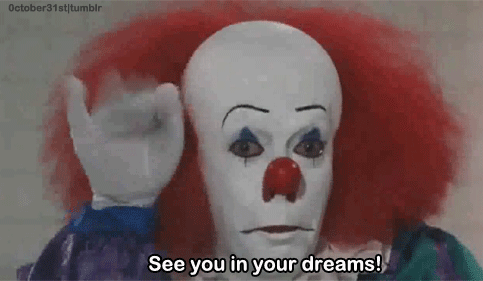A big red nose, a white painted face, and an oversized polka-dot tie. Clowns are a staple for circuses and childhood birthday parties — but also horror movies and nightmares.

Some people are so scared of clowns there is an actual term for it: coulrophobia (though that is not an official diagnosis). The excessive fear of clowns can cause panic, irregular heartbeat, difficulty breathing, sweating, and nausea. It’s also more common in children than adults.
To add to the fear, the movie adaptation of Stephen King’s classic horror story It hit theatres last week, terrifying an entirely new generation who may have not been familiar with the serial-killer clown Pennywise.
WATCH: Coulrophobia, the fear of clowns
While some have a serious phobia of clowns (and probably skipped seeing the movie), a fair number of people have a “healthy apprehension” of them, according to Frank McAndrew, professor of psychology at Knox College.
“We don’t enjoy seeing them as they make us uneasy,” he said. “It’s not a phobia and you may not run away in fear if you see a clown on the street, but it’s not a pleasant experience.”
But if clowns, like Ronald McDonald, are supposed to be figures of fun, why are so many people scared of them?
The clown ‘mask’
Clowns aren’t masked figures, but their painted faces — with large, exaggerated and distorted features — comes close.
“We rely a lot on facial expressions to understand people and see their motivations. And with clowns, you don’t have facial expressions,” Dr. Dena Rabinowitz, a clinical psychologist told Business Insider. “It’s all under makeup, and it’s fixed. And so there’s a kind of a question of, ‘what’s going on under there?'”
Jason Seacat, an associate professor of psychology at Western New England University in Springfield, Mass., agreed.
“The mystery of who is behind the face, the faces are exaggerated, and it’s something that we carry with us that developed early in childhood,” he said.
Familiar — but a bit off
Clowns have a lot of qualities that press the creep detectors in our brain, and one of them is their human-like characteristics, Rabinowitz said.
Many people do not like things that are “familiar, but a little bit off.” Clowns look like people, but there is “an oddity to it,” she said. If we see a clown at a circus it seems relatively normal, but if we see one standing alone in the woods — it can be pretty scary.

This is known as the uncanny valley effect, a phenomenon where things appear to look human but aren’t quite right and can be incredibly unsettling (another reason why some people find dolls and human-like robots scary).

Get breaking National news
The uncertainty of clowns
Clowns are designed for people to be afraid of them, McAndrew said.
“They are mischievous, they play pranks and are designed to be tricksters,” he said. “Right away we are on our guard because they are unpredictable and up to no good.”
WATCH: Mysterious clown spotted roaming the streets of Wisconsin at night

If you are talking to someone and their eye contact is off, you feel uncomfortable because the person is breaking the rules of social norms, he said. This is what happens with clowns.
“You may not scream and run away if a clown comes up to you, as you don’t want to be rude. So you wallow in discomfort.”
Murderous clown
In the 1970s, serial killer John Wayne Gacy appeared at children’s birthday parties and charity events as “Pogo the Clown.” Gacy, also known as the “Killer Clown” is believed to have sexually assaulted, tortured and killed 33 teenagers and young men before he was caught.
He was found guilty in 1980 and given multiple death penalties and life sentences. He was executed by lethal injection on May 10, 1994.

“After Gacy, all the movies started coming out,” McAndrew said. “There was constant reinforcement that a clown equals a serial killer.”
Creepy clowns terrorize the world
In 2016, a phenomenon of “creepy clowns” terrorized people around the globe. Reports of menacing clowns hanging out in the woods or near playgrounds emerged in the U.S., Canada, Europe and Asia, leading to arrests, school warnings, and police investigations.
By Halloween, school principals were warning students not to show up in clown costumes. And some stores pulled clown costumes off the shelf.
The stories even unnerved author Stephen King.
Hollywood and clowns
In 1982, the horror movie, Poltergeist took clown fear to a new level. In the film, the little boy’s clown doll comes to life and tries to drag him under the bed.
In 1986, Stephen King wrote It, in which a terrifying Pennywise the Clown attacks children. This was later made into a television mini-series in 1990 and then a movie in 2017.

In 1988, B-movie hit Killer Klowns from Outer Space hit the theatres, which told the story about an alien band of killer clowns who cocoon their prey in cotton candy.
And then there’s the new American Horror Story. The trailer for Cult is riddled with scary clown imagery.









Comments